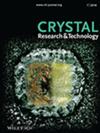锂离子插层剥脱WS2纳米片的电催化析氢性能
IF 1.9
4区 材料科学
Q3 CRYSTALLOGRAPHY
引用次数: 6
摘要
二硫化钨(WS2)作为一种二维层状材料,由于其独特的二维结构、优异的电子性能和催化活性,在电催化领域具有良好的应用前景。然而,由于缺乏活性位点,块状WS2材料的电催化性能受到限制。因此,通过简单的锂离子嵌入剥离方法制备了几层WS2纳米片,与大块WS2相比,电催化析氢性能得到了增强。该方法不仅可以实现WS2纳米片的大规模制备,而且得到的WS2纳米片横向尺寸较大,晶格结构良好,无化学杂质残留。最重要的是,我们认识到WS2纳米片厚度的减小将从超薄的平面结构中产生额外的活性位点,从而提高电催化活性。与本体WS2相比,剥离后的WS2纳米片显示出较小的过电位,在10 mA cm-2下的过电位约为320 mV。研究表明,锂离子插层剥离法是制备二维纳米片材料并有效提高其电催化性能的有效方法。本文章由计算机程序翻译,如有差异,请以英文原文为准。
Li‐Ion Intercalated Exfoliated WS2 Nanosheets with Enhanced Electrocatalytic Hydrogen Evolution Performance
Tungsten disulfide (WS2) as a 2D layered material shows good application in the field of electrocatalysis due to its unique 2D structure, excellent electronic properties, and catalytic activity. However, the electrocatalytic performance of bulk WS2 materials is limited due to the lack of active sites. Hence, a few layers of WS2 nanosheets are prepared by a simple method of lithium (Li)‐ion intercalation exfoliation, and enhanced electrocatalytic hydrogen evolution performance is demonstrated compared to bulk WS2. This method can not only realize the large‐scale preparation of WS2 nanosheets, but also the obtained WS2 nanosheets have a larger lateral size, a good lattice structure, and no chemical impurities remain. Most importantly, it is realized that the reduction in the thickness of WS2 nanosheets will generate additional active sites from the ultrathin planar structure, thereby improving electrocatalytic activity. The exfoliated WS2 nanosheets show a smaller overpotential compared to the bulk WS2, the overpotential is about 320 mV at 10 mA cm–2. This work shows that Li‐ion intercalation exfoliated method is an efficient strategy to prepare 2D nanosheets materials and effectively improve its electrocatalytic performance.
求助全文
通过发布文献求助,成功后即可免费获取论文全文。
去求助
来源期刊
自引率
6.70%
发文量
121
审稿时长
1.9 months
期刊介绍:
The journal Crystal Research and Technology is a pure online Journal (since 2012).
Crystal Research and Technology is an international journal examining all aspects of research within experimental, industrial, and theoretical crystallography. The journal covers the relevant aspects of
-crystal growth techniques and phenomena (including bulk growth, thin films)
-modern crystalline materials (e.g. smart materials, nanocrystals, quasicrystals, liquid crystals)
-industrial crystallisation
-application of crystals in materials science, electronics, data storage, and optics
-experimental, simulation and theoretical studies of the structural properties of crystals
-crystallographic computing

 求助内容:
求助内容: 应助结果提醒方式:
应助结果提醒方式:


